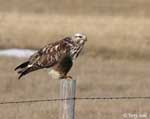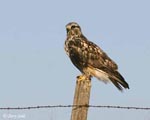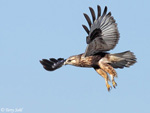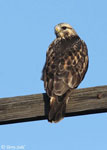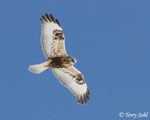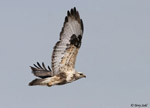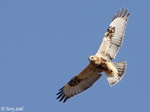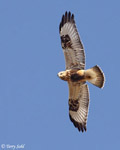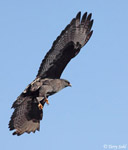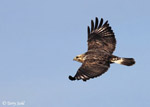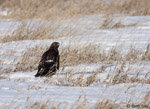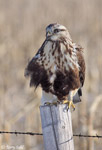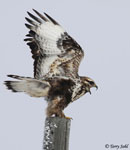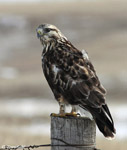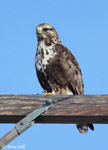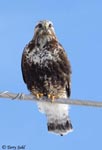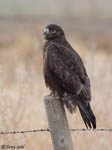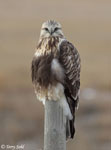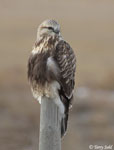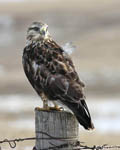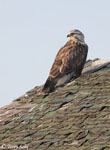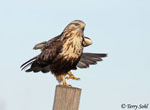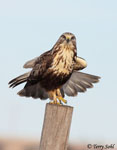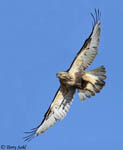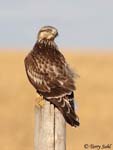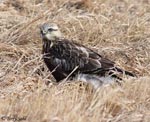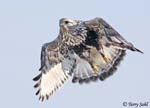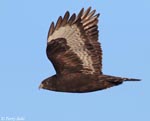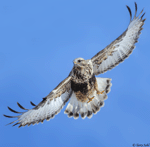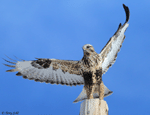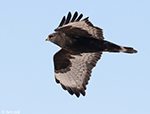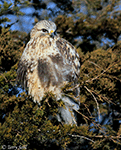| Length: 18- 24 inches | Wingspan: 46 - 54 inches | Seasonality: Winter |
| ID Keys: Light morphs - Black patch on underwing. Dark morphs - Dark leading edge of underwing with white trailing flight feathers. See notes below for ID keys. | ||
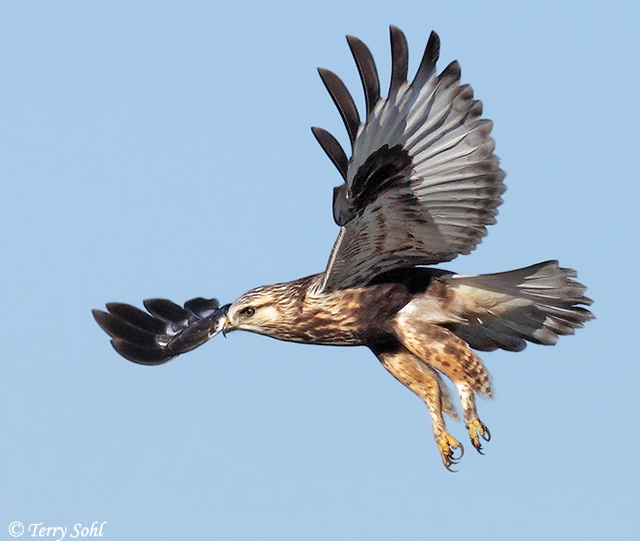 The Rough-legged Hawk is so named because of the feathering that
extends down the legs to the base of the toes, an adaptation to the cold
environments this species prefers. A true cold-weather hawk, they are only
seen in South Dakota in the winter or during migration. Rough-legged Hawks
are one of the few
large hawks that often hunts by hovering. They are also unique
for big Buteo raptors in that they can sometimes perch on very thin branches at
the tops of trees. They are a species that are found throughout the northern
latitudes of both the Eastern and Western Hemisphere. In Europe and Asia they
are referred to as the "Rough-legged Buzzard".
The Rough-legged Hawk is so named because of the feathering that
extends down the legs to the base of the toes, an adaptation to the cold
environments this species prefers. A true cold-weather hawk, they are only
seen in South Dakota in the winter or during migration. Rough-legged Hawks
are one of the few
large hawks that often hunts by hovering. They are also unique
for big Buteo raptors in that they can sometimes perch on very thin branches at
the tops of trees. They are a species that are found throughout the northern
latitudes of both the Eastern and Western Hemisphere. In Europe and Asia they
are referred to as the "Rough-legged Buzzard".
Rough-legged Hawks have multiple color phases, as do other Buteo hawk species, leading to potential confusion in identification. Seasonality is one clue, as Rough-legged Hawks are only present in the lower 48 states during the winter months. Other identification keys can be found below.
Habitat:
Breeds on the edge of the treeline to the tundra near the Arctic. Prefers open country during the winter, such as prairie, open farmland, and desert scrub.
Diet:
Primarily rodents, especially lemmings and voles on its summer breeding grounds in the far North. Will also feed on other rodents (mice, rats, ground squirrels), as well as birds, insects, small lizards, and frogs. Will also feed on carrion.
Behavior:
Often easily distinguished from other large Buteos due to its hunting behavior, as they will often hover over open ground looking for prey. Also will hunt by observing from a perch.
Breeding:
Non-breeder in South Dakota. On their breeding grounds in the Arctic, Rough-legged Hawks nest on open cliffs. The nest itself is constructed with sticks and other sturdy vegetation (and sometimes even animal bones), lined with mosses, feathers, fur, grasses, or other finer and softer material. The female constructs most of the nest, although the male may help gather nesting materials. The female most frequently lays between 2 and 4 eggs, and she does most of the incubation. The young hatch after 32-35 days, and spend another 5 to 7 weeks in the nest prior to fledging.
Song:
Generally quiet during the winter in South Dakota, although the species does have multiple vocalizations. The most common is a screaming "ka-reeee" (listen below), given as an alarm call while in flight or near the nest.
1Click here to hear the alarm call of a Rough-legged Hawk
Migration:
Rough-legged Hawks are strongly migratory. Their breeding grounds are in the far northern Arctic areas of North America (as well as Europe and Asia). Summering grounds in North America are over far southern Canada and much of the United States.
Interactive eBird Map:
Click here to access an interactive eBird map of Rough-legged Hawk sightings
Similar Species:
Buteo hawk species all have variable plumages, and often overlap in range. There are thus many opportunities for confusion in identification. Species most likely to be confused with a Rough-legged hawk in South Dakota are the Red-tailed Hawk, Ferruginous Hawk, and Broad-winged Hawk (although seasonality may help with the latter, as Rough-legged Hawks are winter visitors, while Broad-tailed Hawks are migrants and summer residents). For a detailed summary of how to tell the difference between these (and other) hawk species, click here. While plumage differences are substantial between different color phases of Rough-legged Hawks, some overall identification keys include:
- Tail: White feathers at the base of the tail (with darker feather ends)
- Underwings: Obvious dark "wrist" patch on light-morph birds, while dark-morph Rough-legged Hawks have an obvious two-tone feather pattern, with dark leading edges of the wings and light primary flight feathers (trailing feathers). Primary flight feathers on all morphs are generally light in tone (underside).
- Legs: They're called Rough-legged Hawks for a reason! They do have legs that are feathered all the way to the feet, an adaptation to help conserve heat in their normally cold habitats.
- Bill: If seen well, Rough-legged Hawks have a quite small bill compared to hawks like Red-tailed or Ferruginous Hawks.
- Behavior: Rough-legged Hawks are the only large Buteo hawk that often hunts by hovering in place as they survey the landscape below for prey items. They also have a tendency to perch at the very top of trees in often very slender twigs and branches, while other Buteo hawks usually perch on more substantial branches.
 |
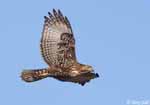 |
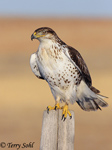 |
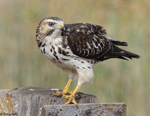 |
| Red-tailed Hawk | Red-tailed Hawk | Ferruginous Hawk | Broad-winged Hawk |
Conservation Status:
Overall populations do fluctuate with changing lemming and vole populations in the Arctic. However, Rough-legged Hawks are a species with an extremely wide geographic range, found throughout the northern latitudes in both the Eastern and Western Hemisphere. Overall numbers are thought to be stable, and they are quite common in many parts of their range. The IUCN considers the Rough-legged Hawk to be a species of "Least Concern".
South Dakota "Hotspot:
The Fort Pierre National Grasslands south of Pierre are normally full of Rough-legged Hawks in the winter. It's not unusual to come across several dozen driving through on a winter day. One of my favorite winter birding trips is to arrive in the Presho area right at dawn (another excellent winter raptor location) and then drive northward into the grasslands.
Further Information:
Photo Information:
November 27th, 2010 - Near Presho in Lyman County, South Dakota -- Terry L. Sohl
Additional Photos:
Click on the image chips or text links below for additional, higher-resolution Rough-legged hawk photos.
Audio File Credits:
1Terje Kolaas. Recorded in the Are Municipality of Sweden on May 8th, 2014. Original recording and information available from xeno-canto.
| Click on the range map for a higher-resolution view |
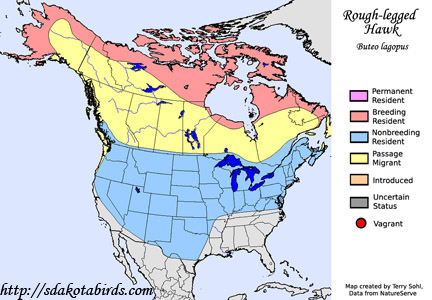 |
| South Dakota Status: Uncommon to common winter resident |
Additional Rough-legged Hawk Photos
Click for a higher-resolution version of these photos
